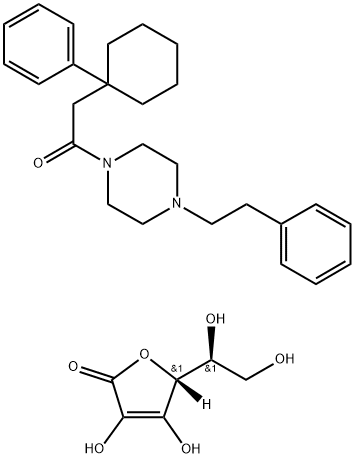(2-Aminoethyl)phosphonic acid
Synonym(s):2-AEP
- CAS NO.:2041-14-7
- Empirical Formula: C2H8NO3P
- Molecular Weight: 125.06
- MDL number: MFCD00008182
- EINECS: 218-043-0
- SAFETY DATA SHEET (SDS)
- Update Date: 2023-05-18 11:31:12

What is (2-Aminoethyl)phosphonic acid?
Chemical properties
WHITE TO BEIGE CRYSTALLINE POWDER
The Uses of (2-Aminoethyl)phosphonic acid
2-Aminoethylphosphonic acid was used as a growth medium for the marine bacterium Roseovarius nubinhibens ISM.
What are the applications of Application
2-Aminoethylphosphonic acid is a growth medium for Roseovarius nubinhibens ISM, a marine bacterium
Definition
ChEBI: A phosphonic acid in which the hydrogen attached to the phosphorus of phosphonic acid is substituted by a 2-aminoethyl group.
Synthesis Reference(s)
Journal of the American Chemical Society, 69, p. 2112, 1947 DOI: 10.1021/ja01201a012
General Description
The surface of gold nanoparticles (Au NPs) were functionalized with 2-aminoethylphosphonic acid that exhibited calcium affinity which enabled targeted delivery of Au NPs to calcified tissue.
Properties of (2-Aminoethyl)phosphonic acid
| Melting point: | 296 °C (dec.) (lit.) |
| Boiling point: | 352.5±44.0 °C(Predicted) |
| Density | 1.482±0.06 g/cm3(Predicted) |
| storage temp. | Keep in dark place,Inert atmosphere,Room temperature |
| solubility | water: soluble50mg/mL, clear, colorless |
| form | Crystalline Powder |
| pka | pK1: 2.45(+1) ;pK2: 7.0(0);pK3: 10.8(-1) (25°C) |
| color | White to beige |
| Water Solubility | Soluble |
| CAS DataBase Reference | 2041-14-7(CAS DataBase Reference) |
Safety information for (2-Aminoethyl)phosphonic acid
| Signal word | Warning |
| Pictogram(s) |
 Exclamation Mark Irritant GHS07 |
| GHS Hazard Statements |
H315:Skin corrosion/irritation H319:Serious eye damage/eye irritation |
| Precautionary Statement Codes |
P264:Wash hands thoroughly after handling. P264:Wash skin thouroughly after handling. P280:Wear protective gloves/protective clothing/eye protection/face protection. P302+P352:IF ON SKIN: wash with plenty of soap and water. P305+P351+P338:IF IN EYES: Rinse cautiously with water for several minutes. Remove contact lenses, if present and easy to do. Continuerinsing. P332+P313:IF SKIN irritation occurs: Get medical advice/attention. P337+P313:IF eye irritation persists: Get medical advice/attention. |
Computed Descriptors for (2-Aminoethyl)phosphonic acid
| InChIKey | QQVDJLLNRSOCEL-UHFFFAOYSA-N |
New Products
(S)-3-Aminobutanenitrile hydrochloride 4-Methylphenylacetic acid N-Boc-D-alaninol N-BOC-D/L-ALANINOL Tert-butyl bis(2-chloroethyl)carbamate 3-Morpholino-1-(4-nitrophenyl)-5,6-dihydropyridin- 2(1H)-one Furan-2,5-Dicarboxylic Acid Tropic acid 1-Bromo-3,5-Di-Tert-Butylbenzene S-2-CHLORO PROPIONIC ACID ETHYL ISOCYANOACETATE 2-Bromo-1,3-Bis(Dimethylamino)Trimethinium Hexafluorophosphate 4-IODO BENZOIC ACID 3-NITRO-2-METHYL ANILINE 1-(2,4-DICHLOROPHENYL) ETHANAMINE (2-Hydroxyphenyl)acetonitrile 4-Bromopyrazole 2-(Cyanocyclohexyl)acetic acid 4-methoxy-3,5-dinitropyridine 1-(4-(aminomethyl)benzyl)urea hydrochloride 2-aminopropyl benzoate hydrochloride diethyl 2-(2-((tertbutoxycarbonyl)amino) ethyl)malonate tert-butyl 4- (ureidomethyl)benzylcarbamate Ethyl-2-chloro((4-methoxyphenyl)hydrazono)acetateRelated products of tetrahydrofuran








You may like
-
 2-Aminoethylphosphonic acid CAS 2041-14-7View Details
2-Aminoethylphosphonic acid CAS 2041-14-7View Details
2041-14-7 -
 2033-24-1 98%View Details
2033-24-1 98%View Details
2033-24-1 -
 1975-50-4 98%View Details
1975-50-4 98%View Details
1975-50-4 -
 2-HYDROXY BENZYL ALCOHOL 98%View Details
2-HYDROXY BENZYL ALCOHOL 98%View Details
90-01-7 -
 2-Chloro-1,3-Bis(Dimethylamino)Trimethinium Hexafluorophosphate 221615-75-4 98%View Details
2-Chloro-1,3-Bis(Dimethylamino)Trimethinium Hexafluorophosphate 221615-75-4 98%View Details
221615-75-4 -
 61397-56-6 CIS BROMO BENZOATE 98%View Details
61397-56-6 CIS BROMO BENZOATE 98%View Details
61397-56-6 -
 14714-50-2 (2-Hydroxyphenyl)acetonitrile 98+View Details
14714-50-2 (2-Hydroxyphenyl)acetonitrile 98+View Details
14714-50-2 -
 118753-70-1 98+View Details
118753-70-1 98+View Details
118753-70-1
Statement: All products displayed on this website are only used for non medical purposes such as industrial applications or scientific research, and cannot be used for clinical diagnosis or treatment of humans or animals. They are not medicinal or edible.